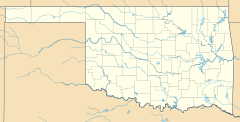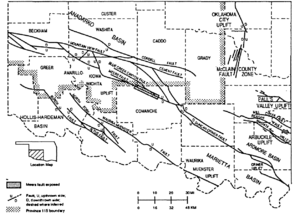Meers, Oklahoma facts for kids
Quick facts for kids
Meers, Oklahoma
|
|
|---|---|

The Meers Store
|
|
| Country | United States |
| State | Oklahoma |
| County | Comanche |
| Elevation | 1,460 ft (450 m) |
| Time zone | UTC-6 (Central (CST)) |
| • Summer (DST) | UTC-5 (CDT) |
| ZIP codes |
73558
|
| FIPS code | 40-47500 |
| GNIS feature ID | 1100624 |
Meers is an unincorporated community located on State Highway 115 in Comanche County, Oklahoma, United States, in the foothills of the Wichita Mountains. In 1901, Meers was founded as a gold prospecting town where it was named in honor of mine operator Andrew J. Meers from Cherokee County, Georgia.
The only remaining structure of the original town is the Meers Store & Restaurant, which Food Network named as the best hamburger joint in Oklahoma and one of the best in the United States, largely due to its signature MeersBurger.
The Meers Store also served as the area post office from March 12, 1902, until February, 1989. Currently, area residents have Lawton mailing addresses.
Contents
Geological formation of Southwest Oklahoma
Meers is defined by a geological displacement or planar fracture known as the Meers Fault. The northwestern Meers fault and the southeastern Meers fault lines are geologically situated in the central lowlands.
In 1985, in order to monitor a seismic event, the Oklahoma Geological Survey installed a seismograph in the Meers Store.
Spanish prospectors in the Wichita Mountains
Wichita Mountains region is believed to have captivated the first Spanish conquistadors in the 16th century, 17th century, and 18th century. The epoch was defined by the geographical exploration of North America as orchestrated by the Spanish Empire during the sixteenth century inland expeditions.
The Spanish colonization of the Americas revealed substantial developments with the establishment of the territorial entities known as New Spain and Spanish Texas. The Red River of the South was explored by the Spaniards originating during the 16th century. The Montague County, Texas administrative division sustains exemplary events chronicled at Spanish Fort, Texas dating to the eighteenth century.
The Spanish Empire explored native kingdoms specifically for gold mining and silver mining collectively as the proprietors of the Treasure of Villena and the Spanish royal crown's decrees often referred to as the Doctrine of Discovery and Laws of the Indies. The monarchy and regal decrees entitled chartering expeditionary campaigns to collect geological and mineral surveys on distant coasts and continents.
The Spanish Empire's exploratory caravans were possessed by the tales of the earlier explorers who exalted the New World's mythic lands. A dominion located in the Terra incognita cartographically recognized as the outlying northern territory of North America. The Spanish conquistadors conceptualized the New World's landscape by a covetous euphoria for the Iberian Peninsula horde beseeching the Seven Cities of Gold treasuring the similarities of the Las Médulas.
The group eleven elements were an alluring earthly possession serving as a periodic element for the crown jewels. The mineral ore forged as a coinage metal or milled coinage for the currency of Spain and Spanish America authentically illustrated by the Spanish escudo. The precious metals were mutually considered a barter and medium of exchange for cultural diplomacy and greetings with native kingdoms.
In 1955, a primitive mill, recognized as an arrastra, was discovered 2 miles (3.2 km) south of Meers near Meers Road or Oklahoma State Highway 115. The 16th-century mill, situated to close proximity of Cedar Creek, was considered to be of Spanish design and origin. The arrastra permitted comminution of earth elements being gold and silver essentially scaling the metallics for protracted overland passages. The fragmentation process formed a suitable ductile element for conveyance by pack saddle.
The Spanish prospector's packhorse route was a southerly journey into the Texas Blackland Prairies migrating into the Lower Rio Grande Valley ― Atascocita Road ― while transitioning to the Gulf Coastal Plain venturing the coastal geography of northeastern Mexico's mountainous region known as Sierra Madre Oriental. The prized noble metal was conferred for transfer on the east coast of Mexico at the port of Veracruz ― San Juan de Ulúa ― treasure port for Spanish Main.
The transition metals encompassed an overland passage — Old Spanish Trail — of the New World to Spanish galleons of the Spanish treasure fleet in St. Augustine, Florida adorned by the Spanish fortification Castillo de San Marcos. Spain's medieval ships would potentially anchor in Havana and Spanish Wells for mustering seafaring provisions, water, and wine. The spanish cargo fleets ― 1715 Treasure Fleet ― continued the nautical voyage with winds sustaining the transatlantic crossing to the Old World in anticipation of the King's treasure homecoming in Cartagena, Spain.
Listing as National Register of Historic Places
The Meers Store was listed on the National Register of Historic Places in 1978 as Meers Mining Camp, since it was the only surviving relic of the community's gold rush days.
Historical Video Archive
| ☆ |
| ☆ |




